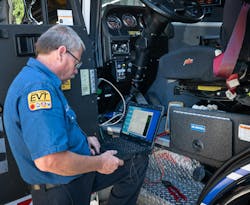Five Technology Upgrades for Fire Apparatus Without Breaking the Bank
Key Takeaways
- The installation of routers onto fire vehicles reduces the potential for spotty signals in the performance of connectivity technology that keeps crews that are en route to an emergency in contact with computer-aided dispatch.
- The lower frequency signals of bass sirens for fire apparatus have a better chance of penetrating the soundproofing of automobiles and noise-cancelling earbuds, to aid in the safety of firefighters and civilians alike.
- On-board tracking and telematics technology for fire apparatus are vital tools for analyzing operations in terms of improving response times.
It’s easy to get nostalgic looking at historic pumpers, but compared with the apparatus that’s produced today, even fire vehicles that are 10 years old are missing some major technological advancements. In a connected world, the most recognizable vehicle that’s on the road—the fire apparatus—quickly is ramping up options to bring information to responders better and faster than before.
Departments that want to provide the best service are leveraging technology upgrades to improve connection stability and redundancy; adding flexible options for crews to access information; investing in built-in information centers; providing proactive and intelligent options for intersection controls (along with bass siren technology); and using services that establish real-time updates on the vehicle’s performance and location.
Get connected
From the inception of radio and eventually internet-based services, a fire apparatus must have the best connections. FirstNet-powered solutions have done a great job of providing priority access to the cell networks. However, spotty signals and even fire stations that block cell signals often lead to crew frustrations as computers search for a connection.
A key piece of equipment that reduces these frustrations is a Cradlepoint router. Ranging in price and options, these routers have robust capabilities, such as being capable of seamlessly switching between internet sources (station Wi-Fi, public Wi-Fi, cell services), using multiple cell services and providing precise GPS tracking. Compared with the old-school options of a hot spot or GPS puck, Cradlepoint routers are more durable, depending on the antenna, which can broadcast signals as far as 100 yards away, and have options for nearly every vehicle setup. The capability to hot-switch between internet sources proves to be the best feature, because it keeps the crew connected with computer-aided dispatch, allows for silent dispatch options (status buttons only) without interruption and creates a truly reliable network connection.
MDTs/tablets
Mobile data terminals (MDTs) are considered a staple in the modern fire service, so much so that many apparatus manufacturers create lowered dash options and premounted hardware for MDTs that don’t block the driver’s view. Compared with even 10 years ago, there are MDT solutions that can fit every apparatus configuration and department budget (e.g., larger laptops, touchscreens, multiscreen command consoles, tablets of all sizes, and various operating systems). Today, there’s no excuse to not have some sort of connection on a rig.
With so many software platforms that are available to the fire service, these MDTs offer access to preplans, drone broadcasting, electronic command boards, firefighter tracking solutions, digital reporting and air management telemetric programs.
Dispatch centers that have advanced technology can share live video of an emergency scene as responders are en route. Essentially, without an MDT, the modern responder is missing key information to make better decisions, which in turn provides better outcomes.
Built-in information centers
Some of the first electronic sensors were added to fire apparatus to help to identify whether a compartment door was left open (a blinking red light). Today’s apparatus can provide so much more information.
Built-in information centers are available in nearly every model of apparatus and provide the driver/officer access to mounted camera systems, lights/emergency lights/siren controls, apparatus system information and on-board diagnostics. If the viewer wants to see who is wearing their seatbelt, track the driver’s speed or identify whether any compartments are open, built-in information centers are a great option.
Intersection controls
The earliest preemption systems relied on a blinking light, infrared signal or the sound of a particular siren to change an intersection light to green from red for an approaching apparatus. However, today, these systems are more robust.
The best systems are connected knowing the path of travel for the apparatus, to ensure that traffic is cleared out well ahead of the apparatus’ arrival, adjusting if the driver chooses to make a turn that wasn’t anticipated on the established route. The systems also offer varying levels of preemption to help to improve the efficiency of other services, to include snowplows, buses and garbage collection.
Although preemption makes traversing intersections during emergency travel safer, they don’t address soundproof cars or pedestrians who are wearing noise-cancelling earbuds, which is why it’s important to investigate bass siren technology. Although there are numerous versions of this type of siren, the concept is the same: Lower frequency signals have a better chance to penetrate the soundproofing and noise-cancellation technology. The best options are sirens that can be felt. If you add both technologies, the ability to navigate to an emergency scene is safer.
Tracking and telematics
Although some crews might not appreciate the concept of Big Brother watching everything, modern fleets often have great tracking and telematics. The best organizations fully leverage these technologies to automate everything from marking an apparatus while it’s en route, out in the area or back in quarters (geofencing), to reducing the workload during apparatus checkouts. Commercial fleets have used these technologies for quite some time to improve preventative maintenance programs and to hold drivers accountable for their driving behaviors. However, as the technologies enter the fire service, they provide vital tools for analyzing scene operations. What route did the driver take to arrive faster than expected? Was everyone wearing their seatbelt while the vehicle was in motion? Did the apparatus just cross a mileage or operation-hour threshold (to trigger a preventative maintenance task)?
These systems can report outside of the apparatus and help decision-makers to understand what’s happening with the apparatus and where it is/has been. The true power comes after a particularly difficult call, when the entire response can be rebuilt from dispatch until the apparatus is parked at the station again. Knowing each apparatus’ route and speed, truly seeing the arrival order, and, in the event of an equipment failure or accident, having access to speed, direction and rider information is invaluable.
Relatively inexpensive
If departments look to keep up with the times, they must invest in some technology upgrades. Better connectivity and the other options that are noted above bring information to the crew and improve the safety of emergency responses and can help to automate care and maintenance of one of the most expensive pieces of equipment that’s used.
The most proactive chiefs look to leverage technology to help their crews. These are relatively small expenditures compared with the benefits that they provide.
Product Spotlight
Streamlined Apparatus Ordering
When you’re in the emergency response business, time always is of the essence. E-ONE is saving departments time with its new E-ONE Select Series fire apparatus. The company streamlined the order-to-delivery process by preselecting the most popular options among 75-, 78- and 100-foot aerials, in single- or tandem-axle configurations, while allowing customization to meet departments’ specific needs.
E-ONE.COM
In-Vehicle Safety System
Ambulance accidents can happen in an instant. That’s why a crucial part of Horton’s DNA is safety, protecting first responders, so they can perform their critical lifesaving duties. HOPS (Horton Occupant Protection System) featuring MBrace now is standard on all of the company’s new ambulances for the attendant seat and for side-facing positions, which include the CPR seat and squad bench.
HORTONAMBULANCE.COM
Electric Apparatus
The revolutionary Volterra platform of electric vehicles from Pierce Manufacturing allows zero-emissions operation when powered by the integrated onboard batteries. The platform also can be coupled to the internal combustion engine to provide continuous and uninterrupted power to the pumping system or drive system. Reduce emissions, minimize fuel and produce less noise without sacrificing performance, functionality and safety.
PIERCEMFG.COM
Brow Light
The Field Series from Whelen Engineering is the only brow light that illuminates the entire field of vision using new revolutionary dynamic beam technology. Putting the light where and when it’s most needed provides 180 degrees of visibility via the company’s innovative near-field and far-field optics. Advanced control of forward-facing white illumination is possible with variable power distribution, selectable turn-on functionality and segment control.
WHELEN.COM/FIELDSERIES
About the Author

Jason Moore
Jason Moore is a 23-year veteran of the fire service who began his career with the U.S. Air Force as a fire protection specialist. Moore is involved with the International Association of Fire Chiefs’ Technology Council and is a founding member/associate director of the Indiana University Crisis Technologies Innovation Lab. He delivered presentations on implementing technology, using technology for community risk reduction and best practices to justify funding for innovative programs. Moore was the keynote speaker at FireFusion 2024 and is a member of the Firehouse Editorial Advisory Board.
